Long-Term Remodeling of Aortoiliac Vessels After Standard EVAR, the Reality to Be Considered
Abstract
1. Introduction
2. Methods
2.1. Definitions of Post-Imaging Data
2.2. Statistical Analysis
3. Results
3.1. Aortoiliac Geometrical Remodeling
3.1.1. Lengths
3.1.2. Angulations
3.1.3. Relation of Demographics and Endografts to Remodeling
3.1.4. Impact of Aortoiliac Geometrical Remodeling in Outcomes
4. Discussion
5. Conclusions
Supplementary Materials
Author Contributions
Funding
Institutional Review Board Statement
Informed Consent Statement
Data Availability Statement
Conflicts of Interest
References
- Gopal, M.; Lau, I.; Harris, J.; Berger, K.; Faries, P.; Marin, M.; Tadros, R. A Review of the Evolution of Abdominal Aortic Endografts and Future Directions. Surg. Technol. Int. 2020, 37, 193–201. [Google Scholar]
- Pitoulias, G.A.; Schulte, S.; Donas, K.P.; Horsch, S. Secondary endovascular and conversion procedures for failed endovascular abdominal aortic aneurysm repair: Can we still be optimistic? Vascular 2009, 17, 15–22. [Google Scholar] [CrossRef]
- Paravastu, S.C.; Jayarajasingam, R.; Cottam, R.; Palfreyman, S.J.; Michaels, J.A.; Thomas, S.M. Endovascular repair of abdominal aortic aneurysm. Cochrane Database Syst. Rev. 2014, 2014, CD004178. [Google Scholar] [CrossRef] [PubMed]
- Columbo, J.A.; Kang, R.; Hoel, A.W.; Kang, J.; Leinweber, K.A.; Tauber, K.S.; Hila, R.; Ramkumar, N.; Sedrakyan, A.; Goodney, P.P. A comparison of reintervention rates after endovascular aneurysm repair between the Vascular Quality Initiative registry, Medicare claims, and chart review. J. Vasc. Surg. 2019, 69, 74–79.e6. [Google Scholar] [CrossRef] [PubMed]
- Tsilimparis, N.; Dayama, A.; Ricotta, J.J., 2nd. Remodeling of aortic aneurysm and aortic neck on follow-up after endovascular repair with suprarenal fixation. J. Vasc. Surg. 2015, 61, 28–34. [Google Scholar] [CrossRef][Green Version]
- Pitoulias, G.A.; Valdivia, A.R.; Hahtapornsawan, S.; Torsello, G.; Pitoulias, A.G.; Austermann, M.; Gandarias, C.; Donas, K.P. Conical neck is strongly associated with proximal failure in standard endovascular aneurysm repair. J. Vasc. Surg. 2017, 66, 1686–1695. [Google Scholar] [CrossRef][Green Version]
- Chatzelas, D.A.; Loutradis, C.N.; Pitoulias, A.G.; Kalogirou, T.E.; Pitoulias, G.A. A systematic review and meta-analysis of proximal aortic neck dilatation after endovascular abdominal aortic aneurysm repair. J. Vasc. Surg. 2023, 77, 941–956.e1. [Google Scholar] [CrossRef]
- Chatzelas, D.A.; Pitoulias, A.G.; Loutradis, C.N.; Zampaka, T.N.; Karkos, C.D.; Christopoulos, D.C.; Pitoulias, G.A. Long-term Evaluation of Proximal Aortic Neck Dilatation After Endovascular Abdominal Aortic Aneurysm Repair With a Variety of Contemporary Endografts. J. Endovasc. Ther. 2023, 32, 87–99. [Google Scholar] [CrossRef] [PubMed]
- Kapetanios, D.; Banafsche, R.; Jerkku, T.; Spanos, K.; Hoffmann, U.; Fiorucci, B.; Rantner, B.; Tsilimparis, N. Current evidence on aortic remodeling after endovascular repair. J. Cardiovasc. Surg. 2019, 60, 186–190. [Google Scholar] [CrossRef] [PubMed]
- van Rijswijk, R.E.; Jebbink, E.G.; Zeebregts, C.J.; Reijnen, M.M.P.J. A systematic review of anatomic predictors of abdominal aortic aneurysm remodeling after endovascular repair. J. Vasc. Surg. 2022, 75, 1777–1785. [Google Scholar] [CrossRef]
- Chandra, V.; Rouer, M.; Garg, T.; Fleischmann, D.; Mell, M. Aortoiliac elongation after endovascular aortic aneurysm repair. Ann. Vasc. Surg. 2015, 29, 891–897. [Google Scholar] [CrossRef]
- Wanhainen, A.; Van Herzeele, I.; Bastos Goncalves, F.; Bellmunt Montoya, S.; Berard, X.; Boyle, J.R.; D’oRia, M.; Prendes, C.F.; Karkos, C.D.; Kazimierczak, A.; et al. Editor’s Choice—European Society for Vascular Surgery (ESVS) 2024 Clinical Practice Guidelines on the Management of Abdominal Aorto-Iliac Artery Aneurysms. Eur. J. Vasc. Endovasc. Surg. 2024, 67, 192–331. [Google Scholar] [CrossRef]
- Pitoulias, G.A.; Donas, K.P.; Schulte, S.; Aslanidou, E.A.; Papadimitriou, D.K. Two-dimensional versus three-dimensional CT angiography in analysis of anatomical suitability for stentgraft repair of abdominal aortic aneurysms. Acta Radiol. 2011, 52, 317–323. [Google Scholar] [CrossRef]
- Litwinski, R.A.; Donayre, C.E.; Chow, S.L.; Song, T.K.; Kopchok, G.; Walot, I.; White, R.A. The role of aortic neck dilation and elongation in the etiology of stent graft migration after endovascular abdominal aortic aneurysm repair with a passive fixation device. J. Vasc. Surg. 2006, 44, 1176–1181. [Google Scholar] [CrossRef]
- Cao, P.; Verzini, F.; Parlani, G.; Rango, P.D.; Parente, B.; Giordano, G.; Mosca, S.; Maselli, A. Predictive factors and clinical consequences of proximal aortic neck dilatation in 230 patients undergoing abdominal aorta aneurysm repair with self- expandable stent-grafts. J. Vasc. Surg. 2003, 37, 1200–1205. [Google Scholar] [CrossRef]
- Filis, K.A.; Galyfos, G.; Sigala, F.; Tsioufis, K.; Tsagos, I.; Karantzikos, G.; Bakoyiannis, C.; Zografos, G. Proximal Aortic Neck Progression: Before and After Abdominal Aortic Aneurysm Treatment. Front. Surg. 2017, 4, 23. [Google Scholar] [CrossRef] [PubMed]
- D’Oria, M.; Di Girolamo, F.G.; Calvagna, C.; Gorgatti, F.; Altamura, N.; Lepidi, S.; Biolo, G.; Fiotti, N. Remodeling of abdominal aortic aneurysm sac following endovascular aortic repair: Association with clinical, surgical, and genetic factors. Cardiovasc. Pathol. 2022, 58, 107405. [Google Scholar] [CrossRef] [PubMed]
- Gray, D.E.; Samaan, C.; Oikonomou, K.; Gruber-Rouh, T.; Schmitz-Rixen, T.; Derwich, W. Age and Oversizing Influence Iliac Dilatation after EVAR. J. Clin. Med. 2022, 11, 7113. [Google Scholar] [CrossRef] [PubMed] [PubMed Central]
- Nana, P.; Spanos, K.; Kouvelos, G.; Dakis, K.; Arnaoutoglou, E.; Giannoukas, A.; Matsagkas, M. The Impact of Iliac Artery Anatomy on Distal Landing Zone After EVAR During the 12-Month Follow-Up. Ann. Vasc. Surg. 2023, 88, 354–362. [Google Scholar] [CrossRef] [PubMed]
- Shaw, P.M.; Loree, J.; Gibbons, R.C. Abdominal Aortic Aneurysm. In StatPearls [Internet]; StatPearls Publishing: Treasure Island, FL, USA, 2023. Available online: https://www.ncbi.nlm.nih.gov/books/NBK470237/ (accessed on 1 July 2025).
- Michineau, S.; Dai, J.; Gervais, M.; Zidi, M.; Clowes, A.W.; Becquemin, J.P.; Michel, J.-B.; Allaire, E. Aortic length changes during abdominal aortic aneurysm formation, expansion and stabilisation in a rat model. Eur. J. Vasc. Endovasc. Surg. 2010, 40, 468–474. [Google Scholar] [CrossRef]
- Yang, S.S.; Yun, W.S. Changes in the Normal Infrarenal Aortic Length and Tortuosity in Elderly People. Vasc. Spec. Int. 2020, 36, 15–20. [Google Scholar] [CrossRef] [PubMed]
- Bruijn, L.E.; Heyligers, J.M.M.; Vriens, P.W.; van Rhijn, J.; Roy, J.; Hamming, J.F.; Gäbel, G.; Lindeman, J.H. Histological evaluation of the aortic wall response following endovascular aneurysm repair and endovascular aneurysm sealing. JVS Vasc. Sci. 2023, 4, 100101. [Google Scholar] [CrossRef]
- Boersen, J.T.; Groot Jebbink, E.; Versluis, M.; Slump, C.H.; Ku, D.N.; de Vries, J.-P.P.; Reijnen, M.M. Flow and wall shear stress characterization after endovascular aneurysm repair and endovascular aneurysm sealing in an infrarenal aneurysm model. J. Vasc. Surg. 2017, 66, 1844–1853. [Google Scholar] [CrossRef] [PubMed]
- Szőnyi, Á.; Balázs, G.; Nyárády, B.B.; Philippovich, M.; Horváth, T.; Dósa, E. Effect of Sex, Age, and Cardiovascular Risk Factors on Aortoiliac Segment Geometry. J. Clin. Med. 2024, 13, 1705. [Google Scholar] [CrossRef]
- Tasso, P.; Raptis, A.; Matsagkas, M.; Rizzini, M.L.; Gallo, D.; Xenos, M.; Morbiducci, U. Abdominal Aortic Aneurysm Endovascular Repair: Profiling Postimplantation Morphometry and Hemodynamics with Image-Based Computational Fluid Dynamics. J. Biomech. Eng. 2018, 140, 111003. [Google Scholar] [CrossRef] [PubMed]
- Boyko, E.J. Observational research--opportunities and limitations. J. Diabetes Complicat. 2013, 27, 642–648. [Google Scholar] [CrossRef]
- D’Oria, M.; Pitoulias, G.; Lepidi, S.; Bellosta, R.; Reijnen, M.M.P.J.; Simonte, G.; Pratesi, G.; Usai, M.V.; Gargiulo, M.; Dias, N.; et al. Mid-Term Outcomes of the Iliac Branch Endoprosthesis with Standardized Combinations of Bridging Stent-Grafts for Endovascular Treatment of Aortoiliac Disease with or Without Co-existing Hypogastric Aneurysms (The HYPROTECT Study). Cardiovasc. Intervent. Radiol. 2024, 47, 1739–1749. [Google Scholar] [CrossRef]
- Long, C.; Katsargyris, A.; Milner, R.; Verhoeven, E.; GREAT Investigators. Five-Year Results for Abdominal Aortic Aneurysm Repair with the GORE EXCLUDER Device: Insights from the Gore Global Registry for Endovascular Aortic Treatment (GREAT). Ann. Vasc. Surg. 2024, 106, 247–254. [Google Scholar] [CrossRef]
- Verhoeven, B.A.; Waasdorp, E.J.; Gorrepati, M.L.; van Herwaarden, J.A.; Vos, J.A.; Wille, J.; Moll, F.L.; Zarins, C.K.; de Vries, J.P. Long-term results of Talent endografts for endovascular abdominal aortic aneurysm repair. J. Vasc. Surg. 2011, 53, 293–298. [Google Scholar] [CrossRef] [PubMed]
- Troisi, N.; Pitoulias, G.; Michelagnoli, S.; Torsello, G.; Stachmann, A.; Bisdas, T.; Li, Y.; Donas, K.P. Preliminary experience with the Endurant II short form stent-graft system. J. Cardiovasc. Surg. 2019, 60, 364–368. [Google Scholar] [CrossRef]
- Georgakarakos, E.; Pitoulias, G.; Schoretsanitis, N.; Argyriou, C.; Mavros, D.M.; Lazarides, M.K.; Georgiadis, G.S. Early Results of the Bolton Treovance Endograft in the Treatment of Abdominal Aortic Aneurysms. J. Endovasc. Ther. 2017, 24, 559–565. [Google Scholar] [CrossRef] [PubMed]
- Gallitto, E.; Gargiulo, M.; Freyrie, A.; Bianchini Massoni, C.; Pini, R.; Mascoli, C.; Faggioli, G.; Stella, A. Results of standard suprarenal fixation endografts for abdominal aortic aneurysms with neck length ≤10 mm in high-risk patients unfit for open repair and fenestrated endograft. J. Vasc. Surg. 2016, 64, 563–570.e1. [Google Scholar] [CrossRef] [PubMed]
- van Keulen, J.W.; de Vries, J.P.; Dekker, H.; Gonçalves, F.B.; Moll, F.L.; Verhagen, H.J.; van Herwaarden, J.A. One-year multicenter results of 100 abdominal aortic aneurysm patients treated with the Endurant stent graft. J. Vasc. Surg. 2011, 54, 609–615. [Google Scholar] [CrossRef] [PubMed]
- Zandvoort, H.J.; Gonçalves, F.B.; Verhagen, H.J.; Werson, D.A.; Moll, F.L.; de Vries, J.P.; van Herwaarden, J.A. Results of endovascular repair of infrarenal aortic aneurysms using the Endurant stent graft. J. Vasc. Surg. 2014, 59, 1195–1202. [Google Scholar] [CrossRef] [PubMed][Green Version]
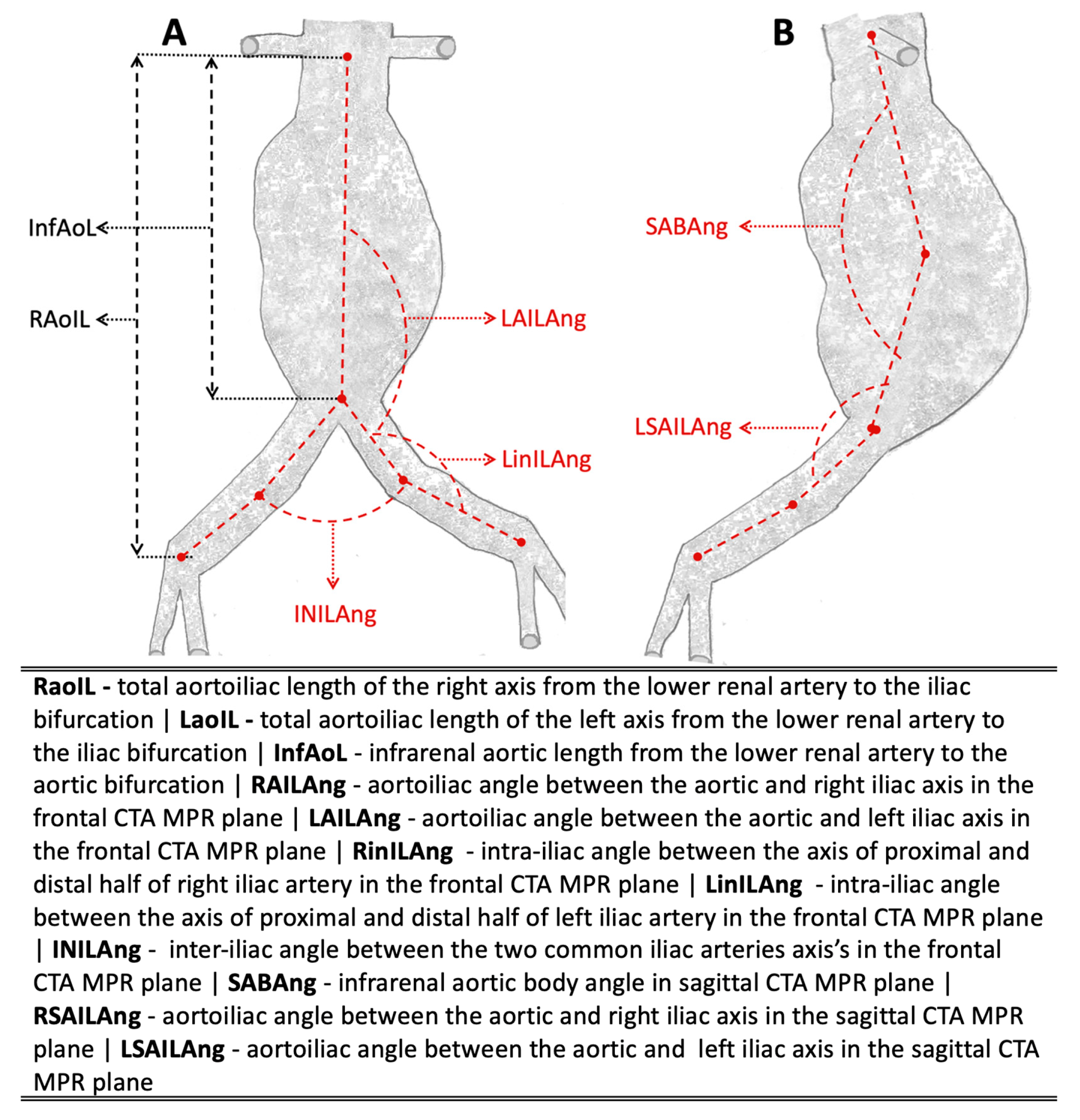
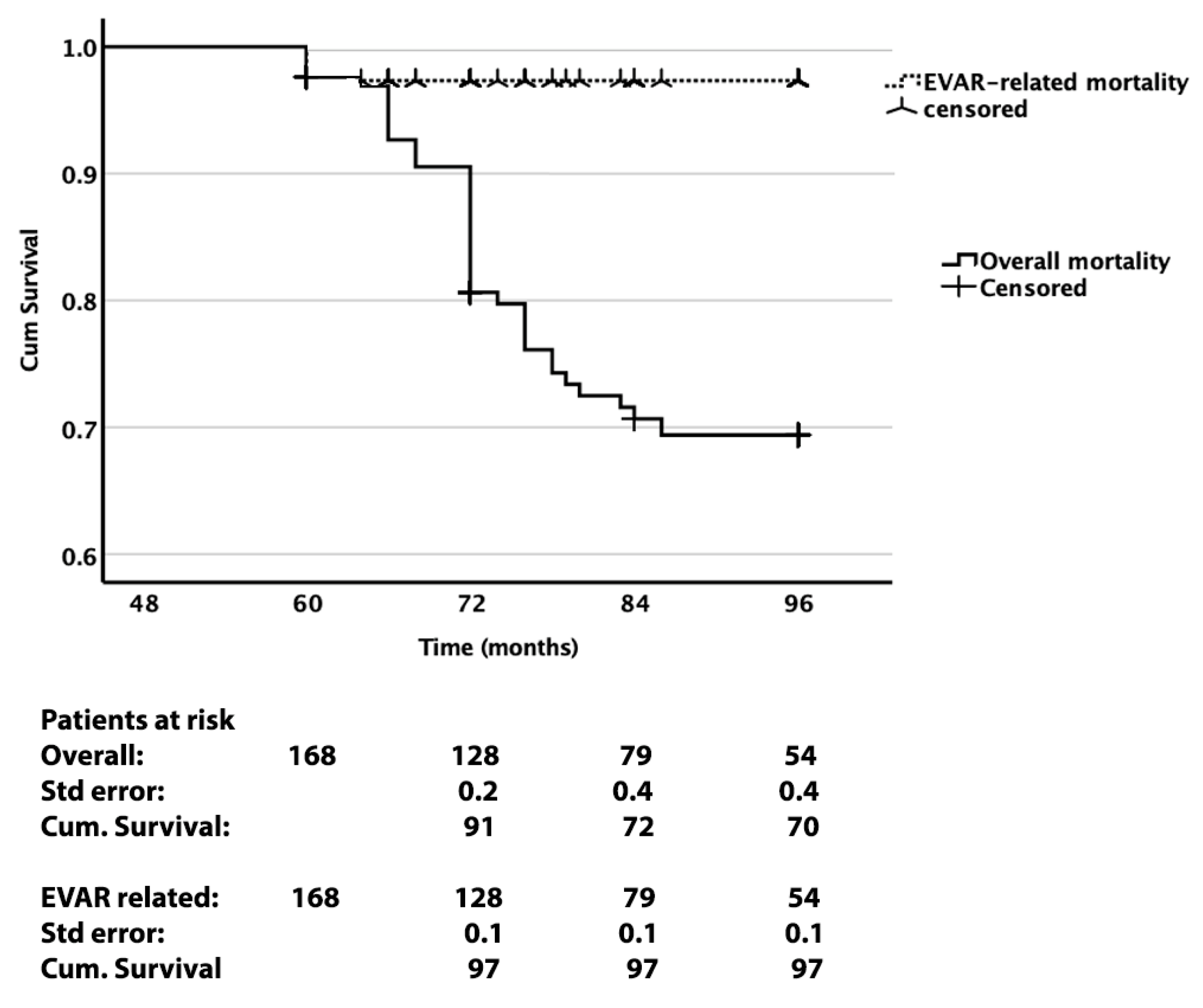
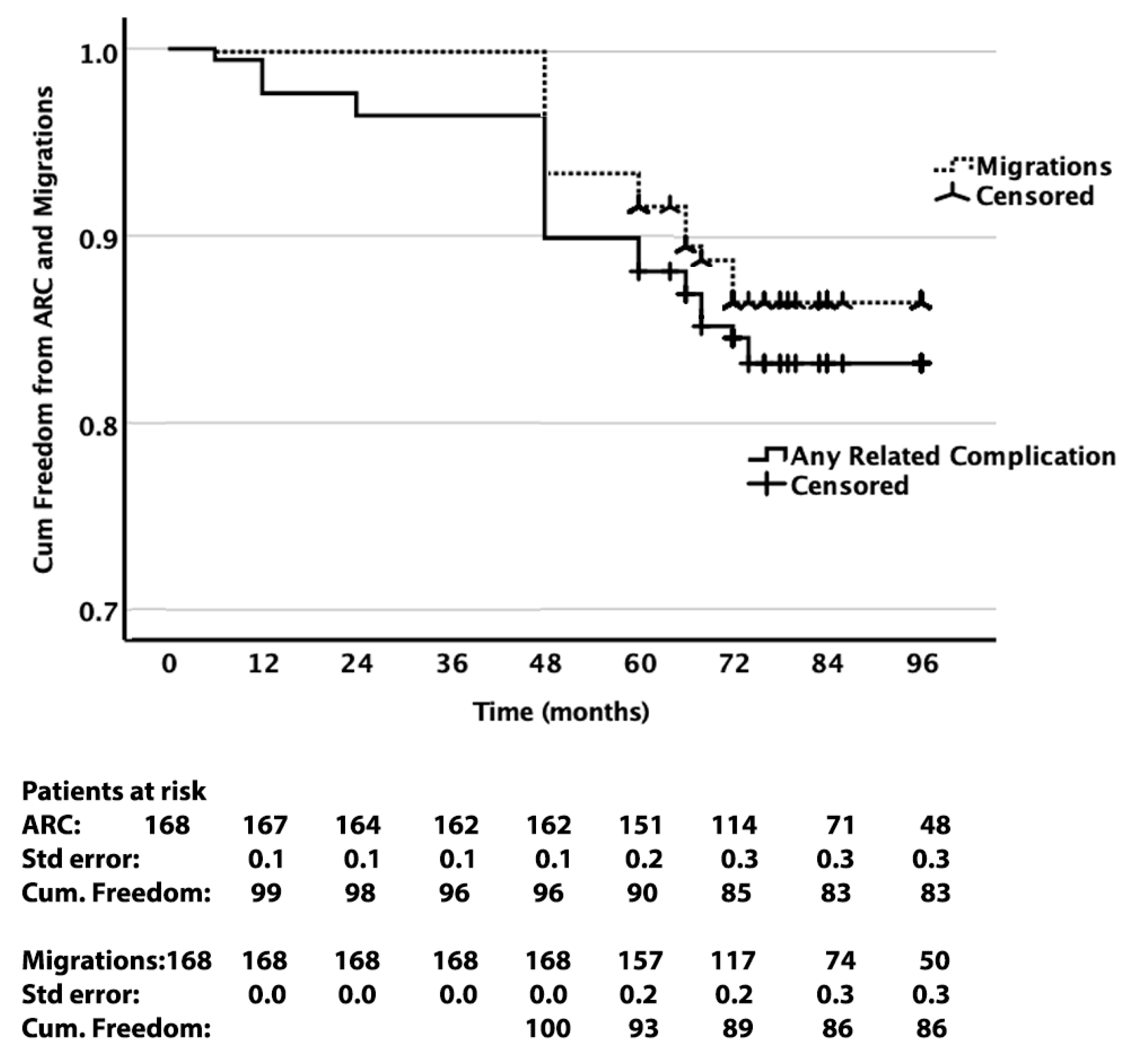
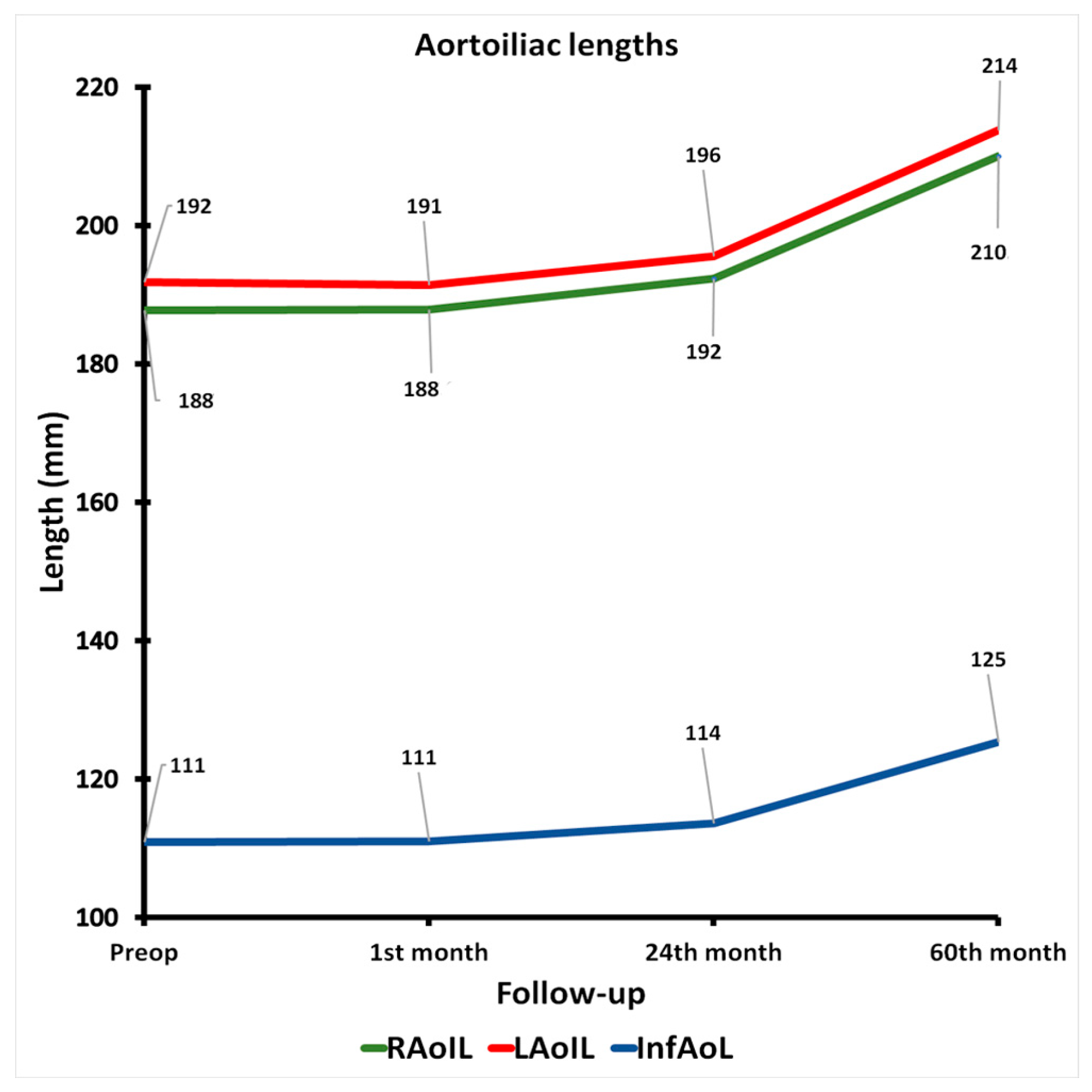
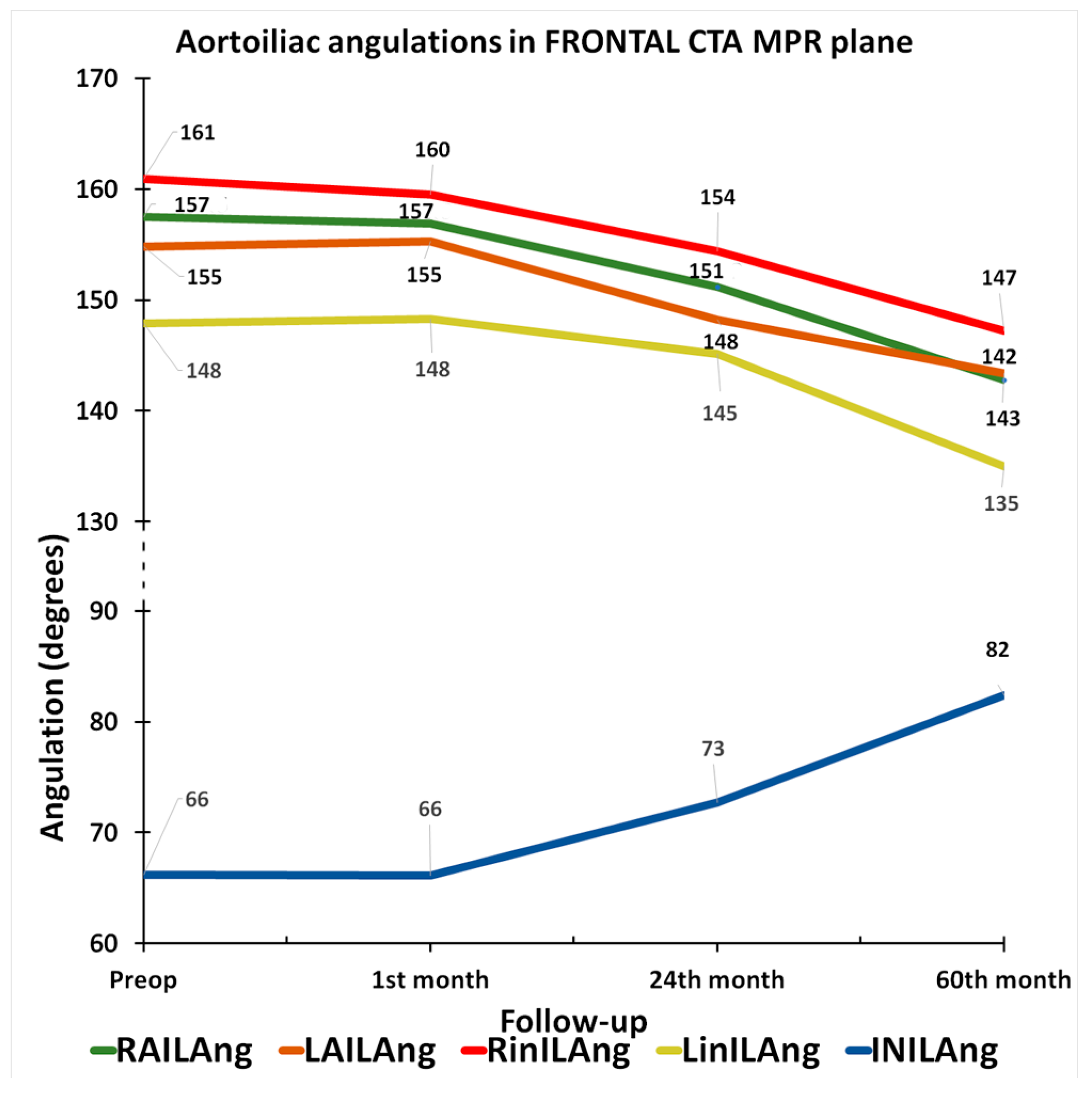
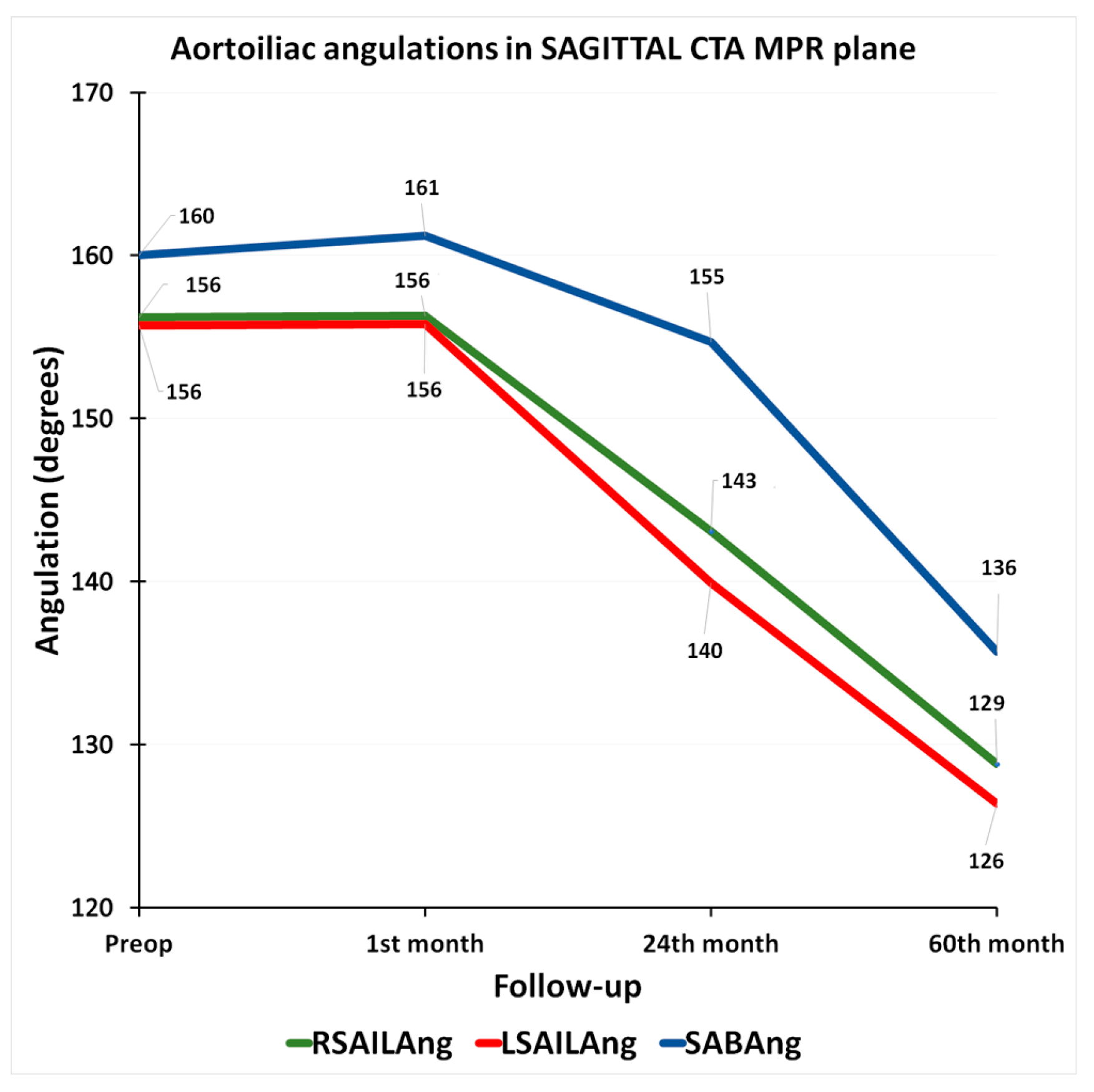
| Total n = 168 * | |
|---|---|
| Demographics | |
| Age (years) | 72.0–9.0 |
| Male gender | 162–96.4 |
| Preoperative clinical status | |
| Hypertension | 152–90.5 |
| Diabetes | 63–37.5 |
| Dyslipidemia | 147–87.5 |
| Coronary artery disease | 70–41.7 |
| Chronic respiratory disease | 19–11.3 |
| Smoking | 114–67.9 |
| Peripheral arterial disease | 16–9.5 |
| Body mass index > 30 | 25–14.9 |
| Antiplatelet | 103–61.3 |
| Statin | 106–63.1 |
| 30-day perioperative data | |
| EVAR operative time (min) | 68.0–25.0 |
| EVAR fluoroscopy time (min) | 11.0–6.0 |
| Contrast medium (ml) | 178.0–60.0 |
| Locoregional anesthesia | 159–94.6 |
| 30-day mortality/morbidity | 0.0–0.0 |
| 30-day endoleak type I, III, or IV | 0.0–0.0 |
| 30-day endoleak type II | 16–9.5 |
| Primary technical success | 168–100.0 |
| 1st Year | 2nd Year | 5th Year | Total Follow-Up | |
|---|---|---|---|---|
| n = 168 | (n—%) | |||
| Endoleak type Ia | 1–0.6 | 0 | 9–5.4 | 13–7.7 |
| Endoleak type Ib | 0 | 0 | 3–1.8 | 7–4.2 |
| Endoleak type III or IV | 0 | 0 | 1–0.6 | 1–0.6 |
| Endoleak type IISG | 0 | 2 ^–1.2 | 0 | 2–1.2 |
| Total endoleaks type Ia, Ib, III, IV, IISG | 1–0.6 | 2–1.2 | 13–7.7 | 23–13.7 |
| Endoleak type II ∝ | 11–6.5 | 12 ^–7.1 | 13–7.7 | 18–10.7 |
| Migration at proximal aortic neck | 0 | 0 | 7–4.2 | 10–6.0 |
| Migration/retraction of iliac limbs | 0 | 0 | 1–0.6 | 5–3.0 |
| Both types of migration | 0 | 0 | 6–3.6 | 6–3.6 |
| Total migrations | 0 | 0 | 14 #–8.3 | 21–12.5 |
| Rupture | 0 | 0 | 3–1.8 | 3–1.8 |
| Limb occlusion | 3 *–1.8 | 0 | 0 | 3–1.8 |
| Related reintervention | 3–1.8 | 2–1.2 | 14 #–8.3 | 25–14.9 |
| Related mortality | 0 | 0 | 4–2.4 | 4–2.4 |
| All related complication events | 4 *–2.4 | 2–1.2 | 14–8.3 | 27–16.1 |
| ARC ^ | Migration * | Failure of Regression # | ||||||||
|---|---|---|---|---|---|---|---|---|---|---|
| Endografts | n—% | 27–16.1 | p | 21–12.5 | p | 73–43.5 | p | |||
| EndurantTM | 58–34.5 | 6–10.3 | 0.08 | 5–8.6 | 0.002 | 18–31.0 | <0.001 | |||
| E-tegra® | 28–16.7 | 2–7.1 | 1–3.6 | 6–21.4 | ||||||
| Treo® | 19–11.3 | 2–10.5 | 1–5.3 | 5–26.3 | ||||||
| AnacondaTM | 22–13.1 | 9–40.9 | 8–36.4 | 16–72.7 | ||||||
| AFX® 2 | 29–17.3 | 7–24.1 | 6–20.7 | 23–79.3 | ||||||
| OvationTM | 12–7.1 | 1–8.3 | 0–0 | 5–41.7 | ||||||
| Total | 168–100 | 27–16.1 | 21–12.5 | 73–43.5 | ||||||
| Endograft features (n–%) | ARC ^ (27–16.1) | |||||||||
| Liner material | n—% | p | ||||||||
| ePTFE (41–24.4) | 8–19.5 | 0.49 | ||||||||
| Dacron (127–75.6) | 19–15.0 | |||||||||
| Type of proximal fixation | ||||||||||
| Suprarenal with hooks (105–62.5) | 10–9.5 | 0.003 | ||||||||
| Infrarenal or suprarenal without hooks (63–37.5) | 17–27.0 | |||||||||
| Migration * (21–12.5) | ||||||||||
| Liner material | n—% | p | ||||||||
| ePTFE (41–24.4) | 6–14.6 | 0.63 | ||||||||
| Dacron (127–75.6) | 15–11.8 | |||||||||
| Type of proximal fixation (n–%) | ||||||||||
| Suprarenal with hooks (105–62.5) | 7–6.7 | 0.003 | ||||||||
| Infrarenal or suprarenal without hooks (63–37.5) | 14–22.2 | |||||||||
| Failure of regression # (73–43.5) | ||||||||||
| Liner material | n—% | p | ||||||||
| ePTFE (41–24.4) | 28–68.3 | <0.001 | ||||||||
| Dacron (127–75.6) | 45–35.4 | |||||||||
| Type of proximal fixation (n–%) | ||||||||||
| Suprarenal with hooks (105–62.5) | 29–27.6 | <0.001 | ||||||||
| Infrarenal or suprarenal without hooks (63–37.5) | 44–69.8 | |||||||||
| 1st vs. 60th %diff * | Age > 71 y p | Hypert # p | Diabetes p | COPD § p | Statin p | Graft p | |
|---|---|---|---|---|---|---|---|
| Lengths | |||||||
| Mean ^ AoIL | 11.5 ± 4.5 | 0.518 | 0.729 | 0.210 | 0.895 | 0.185 | 0.147 |
| InfAoL | 12.9 ± 5.0 | 0.520 | 0.732 | 0.215 | 0.857 | 0.203 | 0.824 |
| Angulations in the frontal CTA MPR plane | |||||||
| Mean ^ AILAng | −8.3 ± 21.3 | 0.275 | 0.234 | 0.622 | 0.244 | 0.225 | 0.726 |
| Mean ^ inILAng | −8.3 ± 23.4 | 0.921 | 0.894 | 0.717 | 0.091 | 0.085 | 0.578 |
| INILAng | 24.9 ± 10.0 | 0.461 | 0.269 | 0.676 | 0.391 | 0.658 | 0.580 |
| Angulations in the sagittal CTA MPR plane | |||||||
| Mean ^ SAILAng | −18.2 ± 19.1 | 0.274 | 0.234 | 0.629 | 0.231 | 0.214 | 0.664 |
| SABAng | −15.1 ± 13.4 | 0.611 | 0.385 | 0.377 | 0.642 | 0.739 | 0.389 |
| Suprarenal Fixation with Hooks | All Migrations | |||||
|---|---|---|---|---|---|---|
| 1 to 60 Months %diff * | Yes, n = 105 | No, n = 63 | p | Yes, n = 21 | No, n = 147 | p |
| Lengths | ||||||
| RAoIL | 11.1 ± 4.3 | 12.6 ± 4.8 | 0.01 | 13.1 ± 3.9 | 11.4 ± 4.6 | 0.04 |
| LAoIL | 10.9 ± 4.2 | 12.3 ± 4.8 | 0.02 | 12.8 ± 3.9 | 11.2 ± 4.5 | 0.04 |
| InfAoL | 12.2 ± 4.7 | 13.9 ± 5.3 | 0.01 | 14.5 ± 4.3 | 12.6 ± 5.0 | 0.04 |
| Angulations in the frontal CTA MPR plane | ||||||
| RAILAng | −10.6 ± 21.6 | −7.0 ± 21.0 | 0.14 | −3.1 ± 21.9 | −10.1 ± 21.1 | 0.17 |
| LAILAng | −8.8 ± 21.7 | −5.0 ± 20.8 | 0.14 | −1.12 ± 22.0 | −8.2 ± 21.2 | 0.17 |
| RinILAng | −8.6 ± 22.6 | −7.6 ± 24.5 | 0.39 | −11.9 ± 24.6 | −7.7 ± 23.1 | 0.46 |
| LinILAng | −8.7 ± 22.9 | −7.6 ± 24.8 | 0.38 | −12.0 ± 24.6 | −7.9 ± 23.4 | 0.47 |
| INILAng | 24.9 ± 9.8 | 24.9 ± 10.3 | 0.49 | 26.6 ± 12.0 | 24.6 ± 9.7 | 0.47 |
| Angulations in the sagittal CTA MPR plane | ||||||
| RSAILAng | −18.7 ± 19.6 | −15.5 ± 18.8 | 0.14 | −12.0 ± 19.8 | −18.3 ± 19.1 | 0.18 |
| LSAILAng | −20.0 ± 19.2 | −16.9 ± 18.4 | 0.14 | −13.4 ± 19.4 | −19.6 ± 18.7 | 0.18 |
| SABAng | −15.0 ± 13.2 | −15.4 ± 14.0 | 0.43 | −19.5 ± 13.5 | −14.5 ± 13.6 | 0.12 |
| Sig. (p) | Exp (B) | 95% C.I. for Exp (B) | |
|---|---|---|---|
| Lower–Upper | |||
| Migrations * (n = 21–12.5%) | |||
| Mean aortoiliac length §, 1 to 60 months %diff ^ | 0.23 | 211.9 | 0.140–320.49 |
| Infrarenal aortic length, 1 to 60 months %diff ^ | 0.22 | 0.059 | 0.001–5.679 |
| Suprarenal fixation with hooks | 0.02 | 0.308 | 0.113–0.843 |
| Failure of Regression # (n = 73–43.5%) | |||
| Mean aortoiliac length 1 to 60 months %diff * | 0.11 | 0.063 | 0.002–1.874 |
| Infrarenal aortic length 1 to 60 months %diff * | 0.10 | 12.331 | 0.571–266.19 |
| Suprarenal fixation with hooks | <0.001 | 5.482 | 2.492–11.089 |
| Percentage of Difference in CTA Measurements | p Value |
|---|---|
| Lengths | |
| Mean aortoiliac length * | <0.001 |
| Infrarenal aortic length | <0.001 |
| Angulations in the frontal CTA plane | |
| Mean aortoiliac angulation * | 0.52 |
| Mean intra-iliac angulation * | 0.88 |
| Interiliac angulation | 0.12 |
| Angulations in the sagittal CTA plane | |
| Mean aortoiliac angulation * | 0.54 |
| Infrarenal aortic body angulation | 0.61 |
Disclaimer/Publisher’s Note: The statements, opinions and data contained in all publications are solely those of the individual author(s) and contributor(s) and not of MDPI and/or the editor(s). MDPI and/or the editor(s) disclaim responsibility for any injury to people or property resulting from any ideas, methods, instructions or products referred to in the content. |
© 2025 by the authors. Licensee MDPI, Basel, Switzerland. This article is an open access article distributed under the terms and conditions of the Creative Commons Attribution (CC BY) license (https://creativecommons.org/licenses/by/4.0/).
Share and Cite
Pitoulias, A.G.; Pitoulias, M.G.; Chatzelas, D.A.; Politi, L.A.; Beropoulis, E.; Wilhelmi, M.; Pitoulias, G.A. Long-Term Remodeling of Aortoiliac Vessels After Standard EVAR, the Reality to Be Considered. J. Clin. Med. 2025, 14, 5626. https://doi.org/10.3390/jcm14165626
Pitoulias AG, Pitoulias MG, Chatzelas DA, Politi LA, Beropoulis E, Wilhelmi M, Pitoulias GA. Long-Term Remodeling of Aortoiliac Vessels After Standard EVAR, the Reality to Be Considered. Journal of Clinical Medicine. 2025; 14(16):5626. https://doi.org/10.3390/jcm14165626
Chicago/Turabian StylePitoulias, Apostolos G., Matthaios G. Pitoulias, Dimitrios A. Chatzelas, Loukia A. Politi, Efthymios Beropoulis, Mathias Wilhelmi, and Georgios A. Pitoulias. 2025. "Long-Term Remodeling of Aortoiliac Vessels After Standard EVAR, the Reality to Be Considered" Journal of Clinical Medicine 14, no. 16: 5626. https://doi.org/10.3390/jcm14165626
APA StylePitoulias, A. G., Pitoulias, M. G., Chatzelas, D. A., Politi, L. A., Beropoulis, E., Wilhelmi, M., & Pitoulias, G. A. (2025). Long-Term Remodeling of Aortoiliac Vessels After Standard EVAR, the Reality to Be Considered. Journal of Clinical Medicine, 14(16), 5626. https://doi.org/10.3390/jcm14165626





